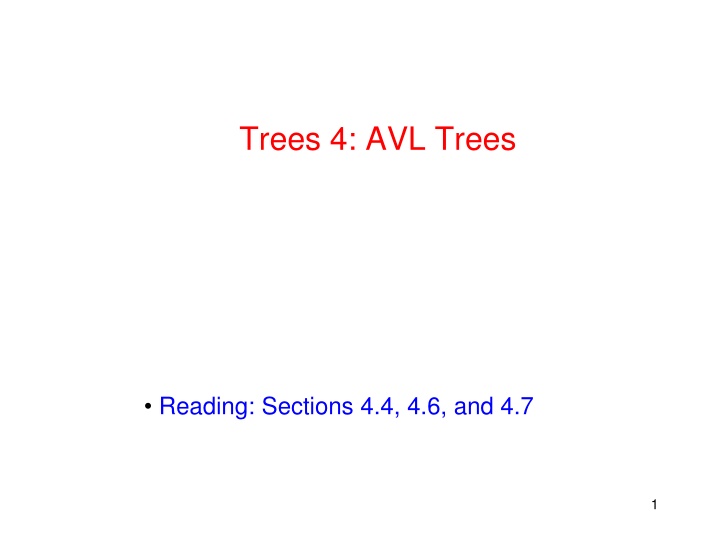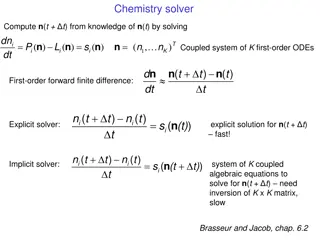
AVL Trees and Their Heights
Explore the concept of AVL trees in balanced binary search trees, their motivation for maintaining optimal height, and how the node structure ensures logarithmic complexity for essential operations. Learn how the size of AVL trees scales with their height, guaranteeing efficient searches, inserts, and removals.
Download Presentation

Please find below an Image/Link to download the presentation.
The content on the website is provided AS IS for your information and personal use only. It may not be sold, licensed, or shared on other websites without obtaining consent from the author. If you encounter any issues during the download, it is possible that the publisher has removed the file from their server.
You are allowed to download the files provided on this website for personal or commercial use, subject to the condition that they are used lawfully. All files are the property of their respective owners.
The content on the website is provided AS IS for your information and personal use only. It may not be sold, licensed, or shared on other websites without obtaining consent from the author.
E N D
Presentation Transcript
Trees 4: AVL Trees Reading: Sections 4.4, 4.6, and 4.7 1
Motivation of a balanced binary search tree Binary search tree has very simple search, insert and remove algorithms The complexity of all of the above operations is O(H) where H is the height of the tree Binary search tree does not guarantee a small H: in the worst case, H = N or (O(N)). Give a scenario that we build a bad binary tree It would be ideal if we can maintain a binary search tree whose height H = O(lg(N))! Search, insert, remove, findmin, findmax all have O(lg(N)) complexity! Balanced binary search tree achieves this! 2
AVL (Adelson-Velskii and Landis) Trees AVL tree is one of such balanced binary search trees! AVL tree is binary search tree with the balance condition For every node in tree, height of left and right subtree can differ by at most 1 This condition guarantees that H = O(log(N)) 3
Height of AVL Trees To understand the height of AVL tree, let us first consider the full complete binary tree (every node either has two children or no child): Let the number of nodes in the complete binary tree with height of H be ??. The tree consists two full complete binary trees of height H-1 plus the root. ?? = 2?? 1+ 1 2 ?? 1 2 2 ?? 2 2??1 ?? 2? ? lg(??) Tree size doubles when the tree height increases by 1, the tree height is lg(N). 5
Height of AVL Trees For every node in tree, height of left and right subtree can differ by at most 1 Let the number of nodes in the smallest AVL tree with height of H be ??. What can we say about the number of nodes in the left subtree in the smallest AVL tree? The tree height is at least H-2, so it has at least ?? 2 nodes. Similarly, the right subtree will have at least ?? 2 nodes Thus, we have ?? 1 + ?? 2+ ?? 2 2?? 2 The size of the smallest complete tree doubles adding 1 level, H = lg(N) The size of the smallest AVL tree doubles adding 2 levels, H = ??? 6
Height of AVL Trees Let ?? be the size of the smallest AVL tree of height H, We have ?? 2?? 2 So ?? 2?? 2 2 2?? 4 2 2 2 ?? 6 How many times do we need to expand for the term to be ?0 or ?1 ? ? 2 ?? 2 Thus, ? 2lg ??, and H=O(lg(N)). Another way to look at this is that the AVL tree size at least doubles when H increases by 2, so the tree only needs to be twice as height as the full complete binary tree to have the same number of tree nodes. 7
AVL (Adelson-Velskii and Landis) Trees AVL tree is a balanced binary search tree! AVL tree is binary search tree with the balance condition that guarantees that H = O(lg(N)) What is the balance condition? If we can maintain the balance condition in the insert and remove operations to AVL tree (with O(H) for each insert and remove, we have a data structure that achives O(lg(N)) for search, insert, and remove. A set of O(1) Rotate operations if condition violated when inserting/removing nodes 8
AVL Trees Overhead Extra space for maintaining height information at each node (used to maintain the tree balance). Advantage Insert, remove, and search operations are all O(log(N)) 9
Insertion into AVL tree Insert into a BST tree If the tree is no longer a AVL tree after insertion, perform correction operations to make it a AVL tree again. It turns out that the correction operation only need to perform on the deepest node when the AVL tree property is violated! How to find this node? 10
Balance Condition Violation after insertion Violation cases at node k (deepest node) Case 1: the new node is inserted into the left subtree of k Can k has no left child in this case? Case 2: the node is inserted into the right subtree of k Can k have no right child in this case? If a node inserted into the left sub-tree of k causing the AVL property being violated, k must have a left child If a node inserted into the right sub-tree of k causing the AVL property being violated, k must have a right child So we further partition the cases into four cases, which is easier for the correction operation! 11
Balance Condition Violation after insertion Violation cases at node k (deepest node) Case 1: an insertion into left subtree of left child of k Case 2: an insertion into right subtree of left child of k Case 3: an insertion into left subtree of right child of k Case 4: insertion into right subtree of right child of k Cases 1 and 4 equivalent Single rotation to rebalance Cases 2 and 3 equivalent Double rotation to rebalance 12
Balance Condition Violation after insertion Violation cases at node k (deepest node) Case 1: an insertion into left subtree of left child of k Case 2: an insertion into right subtree of left child of k Case 3: an insertion into left subtree of right child of k Case 4: insertion into right subtree of right child of k Example: insert 10 (case 1) to the left tree, insert 300 to the right tree (case 4). How about case 2 and case 3? 100 100 50 200 13
Balance Condition Violation after insertion Example: insert 10 (case 1) to the tree. 100 50 100 50 100 50 10 Rotation: some local pointer adjustments 10 Balanced tree Tree is balanced again. Tree becomes imbalanced after insertion 14
Single Rotation (Case 1) Reeplace node k2 by node k1 Set node k2 to be right child of node k1 Set subtree Y to be left child of node k2 15
Single Rotation (Case 1) Before the insertion: X, Y, Z have the same height (why?) The tree height at k1 after the insertion is the same the tree height at k2 before insertion (why?) The rest of the tree still meet the AVL tree requirement. No more fixes are needed. 16
Example After inserting 6 Balance condition at node 8 is violated 17
Another example: How would the tree looks like after insert 1 to the following tree? 50 10 100 8 20 18
Single Rotation (Case 4) Replace node k1 by node k2 Set node k1 to be left child of node k2 Set subtree Y to be right child of node k1 19
Example Inserting 3, 2, 1, and then 4 to 7 sequentially into empty AVL tree 3 2 2 3 1 1 20
Example (Contd) Inserting 4 2 3 1 4 Inserting 5 2 3 1 4 5 21
Example (Contd) Inserting 5 2 2 3 1 4 1 4 5 3 5 22
Example (Contd) Inserting 6 2 4 1 5 3 6 23
Example (Contd) Inserting 6 4 2 2 5 4 1 6 1 3 5 3 6 Inserting 7 4 2 5 6 1 3 7 24
Example (Contd) Inserting 6 4 2 2 5 4 1 6 1 3 5 3 6 Inserting 7 4 4 2 6 2 5 7 1 3 5 6 1 3 7 25
Summary Find the deepest node whose AVL property is violated Consider only the nodes from the root to the new node Perform the (single) rotation and done! 26
Single Rotation for case 2? Does not work Consider a simple case 2: insert 70 to the following tree. After single rotation, the tree still not balanced Double rotations needed for case 2 and case 3 100 50 27
More generally, single rotation does not work for Cases 2 and 3 After single rotation, k1 still not balanced Double rotations are needed for case 2 and case 3 28
Double Rotation (Case 2) Left-right double rotation to fix case 2 First rotate between k1 and k2 Then rotate between k2 and k3 29
Double Rotation (Case 2) We always have k1, k2, k3 after the insertion in case 2 What about A, B, C, D? After the insertion, the height of k2 must grow by 1 D s height is 1 less than k2 s height before rotation D s height is either the same as C or 1 more: K3 is balanced after rotation A s height is equal to k2 s height before rotation A s height is either the same as B or 1 more: K1 is balanced after rotation After the rotation, the tree height is the same as the tree before rotation 30
Double Rotation (Case 3) Right-left double rotation to fix case 3 First rotate between k2 and k3 Then rotate between k1 and k2 31
Example Continuing the previous example by inserting 16 down to 10, and then 8 and 9 Inserting 16 and 15 4 4 2 6 2 6 15 1 3 5 7 1 3 5 7 16 16 15 32
Example (Contd) Inserting 14 4 4 2 7 2 6 15 1 3 6 15 1 3 5 16 14 7 16 5 14 Other cases as exercises 33
Summary The four fixing operations do not need to relate to insert or remove operation. We can just look at the tree and do the fixing. The left of the left is too tall: Apply case 1 The right of the left is too tall: Apply case 2 The left of the right is too tall: Apply case 3 The right of the right is too tall: Apply case 4 These fixings will make the tree AVL tree for the node and its descendents, but may change the tree height. For the insertion case, the tree height does not change. 36
Delete Single rotation or double rotation are both O(1). Depending on the shape of the tree, either single rotation or double rotation will fix the AVL property of one node Delete can be done by deleting as in BST delete, and then fix all nodes along the path from the root to the deleted node, this would take at most O(lg(N)) 37
Implementation of AVL Tree struct AvlNode { Comparable AvlNode AvlNode int element; *left; *right; height; AvlNode( const Comparable & ele, AvlNode *lt, AvlNode *rt, int h = 0 ) : element{ ele }, left{ lt }, right{ rt }, height{ h } { } AvlNode( Comparable && ele, AvlNode *lt, AvlNode *rt, int h = 0 ) : element{ std::move( ele ) }, left{ lt }, right{ rt }, height{ h } { } }; /** * Return the height of node t or -1 if nullptr. */ int height( AvlNode *t ) const { return t == nullptr ? -1 : t->height; } 38
Insertion into an AVL Tree /** * Internal method to insert into a subtree. * x is the item to insert. * t is the node that roots the subtree. * Set the new root of the subtree. */ void insert( const Comparable & x, AvlNode * & t ) { if( t == nullptr ) t = new AvlNode{ x, nullptr, nullptr }; else if( x < t->element ) insert( x, t->left ); else if( t->element < x ) insert( x, t->right ); balance( t ); } 39
Insertion into an AVL Tree (Contd) static const int ALLOWED_IMBALANCE = 1; // Assume t is balanced or within one of being balanced void balance( AvlNode * & t ) { if( t == nullptr ) return; if( height( t->left ) - height( t->right ) > ALLOWED_IMBALANCE ) if( height( t->left->left ) >= height( t->left->right ) ) rotateWithLeftChild( t ); else doubleWithLeftChild( t ); else if( height( t->right ) - height( t->left ) > ALLOWED_IMBALANCE ) if( height( t->right->right ) >= height( t->right->left ) ) rotateWithRightChild( t ); else doubleWithRightChild( t ); t->height = max( height( t->left ), height( t->right ) ) + 1; } Case 1 Case 2 Case 4 Case 3 40
Remove Just do the binary search tree remove, and then call balance(t) at the end. See the book for the code. 43













